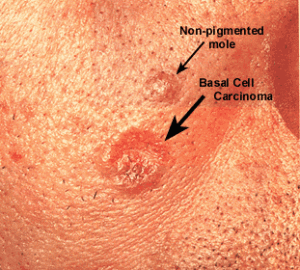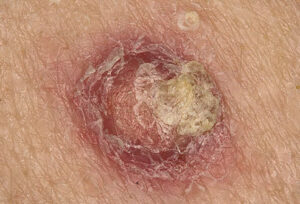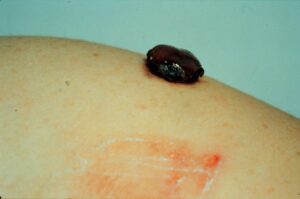

We detected that you're using an older version of Internet Explorer. please upgrade IE 11 or later
Alternatively, you can install and use these secure and newest browsers: Chrome | Firefox | Safari for MacOS | Edge for Windows

When a skin cancer biopsy returns positive for cancer, the news can feel devastating. The incidence of melanoma, the most aggressive form of skin cancer, has steadily risen over the past ten years. Yet when caught early and treated appropriately, patients have an excellent prognosis for a full recovery with minimal discomfort. Perri Dermatology, PLLC provides Skin Cancer Treatment for The Woodlands, Conroe, and Spring, TX.
An annual skin cancer exam by your dermatologist can quickly distinguish normal moles and skin tags from suspicious ones. After a biopsy determines the type of skin cancer, your dermatologist will create a treatment plan to ensure the complete removal of cancer. The three different types of skin cancer are Basal cell, Squamous cell, and melanoma.
 Basal cell carcinoma is the most common type of skin cancer. Basal cell cancers affect more than four million American’s every year, a number that continues to rise. Annual deaths from Basal cell cancers range between two and three thousand people. Anyone can develop this type of skin cancer, but basal cell carcinoma is most common in people who have fair skin. It appears as a flesh-colored round bump or a pink-colored patch of skin. Basal cell cancers are most commonly found on the head, neck, and arms, as these are the areas of the body that receive the most sun exposure.
Basal cell carcinoma is the most common type of skin cancer. Basal cell cancers affect more than four million American’s every year, a number that continues to rise. Annual deaths from Basal cell cancers range between two and three thousand people. Anyone can develop this type of skin cancer, but basal cell carcinoma is most common in people who have fair skin. It appears as a flesh-colored round bump or a pink-colored patch of skin. Basal cell cancers are most commonly found on the head, neck, and arms, as these are the areas of the body that receive the most sun exposure.
 Squamous cell carcinoma is considered the second most common skin cancer. This type of cancer is common in those with fair skin and appears as a firm red bump, a scaly patch, or a sore that continues to heal and re-open. Squamous cell cancers form on skin that is frequently exposed to the sun. Squamous cell cancers affect between one and two million people annually, and their death rate is approximately fifteen thousand each year. Early detection and treatment are essential to prevent squamous cell carcinoma from growing deep into the tissue or spreading to other areas.
Squamous cell carcinoma is considered the second most common skin cancer. This type of cancer is common in those with fair skin and appears as a firm red bump, a scaly patch, or a sore that continues to heal and re-open. Squamous cell cancers form on skin that is frequently exposed to the sun. Squamous cell cancers affect between one and two million people annually, and their death rate is approximately fifteen thousand each year. Early detection and treatment are essential to prevent squamous cell carcinoma from growing deep into the tissue or spreading to other areas.
 Melanoma diagnoses account for only approximately one percent of skin cancers, yet this skin cancer remains the deadliest. More than one hundred thousand Americans will be diagnosed with melanoma this year, and approximately seven thousand of them will lose their lives. Melanoma is significantly more common in Caucasians. The risk for developing melanoma increases with age, but it is quite common in anyone younger than thirty. Melanoma can develop within a mole already present on the skin or appear suddenly as a dark spot that looks different from others. Early diagnosis and treatment are crucial to treatment success.
Melanoma diagnoses account for only approximately one percent of skin cancers, yet this skin cancer remains the deadliest. More than one hundred thousand Americans will be diagnosed with melanoma this year, and approximately seven thousand of them will lose their lives. Melanoma is significantly more common in Caucasians. The risk for developing melanoma increases with age, but it is quite common in anyone younger than thirty. Melanoma can develop within a mole already present on the skin or appear suddenly as a dark spot that looks different from others. Early diagnosis and treatment are crucial to treatment success.
Dr. Perri bases all treatment on the location, depth, and width of the cancer to find the right option for your specific situation. Most skin cancer treatment can be performed with a local anesthetic at Dr. Perri’s office in The Woodlands or Conroe. In addition to the type of skin cancer and its location, Dr. Perri uses certain measurements to determine the treatment that will be most successful for your type of skin cancer. The two measurements used in melanoma are:
Breslow’s depth helps Dr. Perri determine how far melanoma has spread into the body. Understanding the depth of melanoma is essential for deciding future treatment. The tumor thickness is measured from the top of the tumor to the bottom of the deepest tumor cells. Thin tumors (or stage 0) are those where the melanoma cells remain present only in the skin’s outer layers. Thicker tumors or deeper tumors (stage three or four) are considered advanced and more challenging to treat. In these cases, the melanoma cells have spread to nearby nodes or even other areas of the body.
Clark’s level is a type of staging system that describes the depth of the melanoma tumor as it grows in the skin. Like Breslow’s depth, the depth of the tumor is measured, and a level is determined. Clarks level ranges from level one, where the melanoma is confined to the outer layer of skin, to level five, where the melanoma has reached the fat layer. These measurements are different than Breslow’s depth as they do not consider whether the cancer cells have spread to other areas of the body. Dr. Perri may provide both a level and a stage. These numbers mean different things.
These measurements provide Dr. Perri with an overview of how aggressive your melanoma is. From that point, he can provide patients in The Woodlands and Conroe with the option that has the highest chance of success.
Although affecting approximately 1% of skin cancer patients, melanoma is responsible for the majority of deaths related to skin cancer. Melanoma can be broken into two categories based on depth and location:
The earliest stage of melanoma. Cancer is limited to the epidermis (topmost layers of skin). Dr. Perri will remove the cancer as well as a 1 cm margin of skin under local anesthesia in his office.
Melanoma has progressed beyond the upper layers of skin. Patients may require outpatient surgery under general anesthesia. A wider margin of skin will need to be removed, and sometimes lymph node biopsy is performed to assess whether the melanoma has progressed to local lymph nodes.
The recommended treatment for this type of skin cancer is to remove the entire area of skin and a small margin of healthy skin. This method of excision, known as free surgical margins, significantly reduces the risk of cancer from returning to this area and developing in the surrounding regions.
Both basal and squamous cell cancer have lower mortality rates than melanoma. However, patients will need to undergo treatment to remove the cancer and prevent its spread to tissue and bones. Treatment for basal and squamous cell cancer tends to be less invasive and is broken into four categories:
During a skin cancer excision, the cancer, as well as a 5 mm skin margin, is removed. This is performed under local anesthesia at Dr. Perri’s office.
Moh’s surgery is reserved for more sensitive areas such as the lips, nose, and ears, this treatment addresses very large, aggressive cancer by removing skin one layer at a time. After removal, the Moh’s surgeon will examine each layer under a microscope to determine if he needs to continue. This procedure is performed in-office under local anesthesia.
For small, non-aggressive cancer, patients receive treatment in Dr. Perri’s office under local anesthesia. A curette is used to scrape away cancer cells. The treatment area is then desiccated using a hyfrecator.
Certain medications for skin cancer treatment can remove superficial cancer in low-risk areas such as the trunk, arms, and legs. Patients apply a topical cream such as 5-fluorouracil or efudex every day for 1-2 months. The treated area becomes inflamed and irritated, eliminating the cancer.
While the ultimate choice of treatment is at the discretion of each patient, Dr. Perri cautions patients that milder forms of cancer treatment may not be as effective as excision and Moh’s surgery for long-term prevention.
Skin cancer patients have an excellent chance of recovering from skin cancer, and mortality rates are very low. However, because melanoma is on the rise, Dr. Perri recommends that patients come in for an annual skin examination to identify signs of skin cancer and seek treatment early to avoid more invasive procedures.
Perri Dermatology, PLLC provides skin cancer treatments to help patients stay healthy in The Woodlands, TX, Conroe, TX, and Spring, TX. Successful treatment for any type of skin cancer requires early detection, so do not wait to have a skin cancer screening and treatment consultation. Schedule your appointment online or call (936) 522-4966 to reach one of our offices in The Woodlands and in Conroe today.
Read our reviews to see other patients’ experiences with visiting Perri Dermatology.
We accept medical insurance to help cover the cost of our medical dermatology procedures.
New patients can download their medical forms from our website before their appointment.